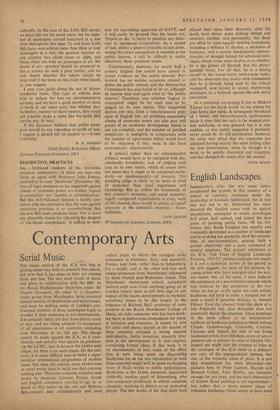Contemporary Arts
Serial Music
THE, music section of the ICA was late in getting under way with its concerts this season, but now that it has done so they are coming thick and fast. The two most recent of them, one given in collaboration with the BBC by the Royal Philharmonic Orchestra under Sir Eugene Goossens, the other by a chamber- music group from Manchester, have consisted almost entirely of twelve-note and serial music, and must be making some of London's pro- fessional resisters of these techniques begin to wonder if their resistance is not unreasonable. It is certainly futile, for they have clearly come to stay, and arc being adopted by composers of all generations in all countries—including even Stravinsky in his old age. The charge cannot be made against the ICA, as it occa- sionally and unfairly was against its predeces- sor the LCMC, that it favours the twelve-note clique, for there is no such clique. On the con- trary, it is more difficult now to build a repre- sentative international programme of modern music that dogs not contain wine twelve-note or serial works than to build one that contains nothing else. These two concerts included such works by Austrian, German, Italian, Greek and English composers, varying in age by as much as fifty years--at the one end Webers, Schoenberg's near contemporary and most
radical pupil, to whom the youngest serial composers in Germany, Italy, and especially France, now look, rather than to Schoenberg, for a model, and at the other end two such young composers from Manchester, influenced by these French post-Webernian trends. This Manchester twelve-note school, completely isolated until now from anything going on in London (where there is still little sign of any impact of the recent developments in rhythmic serialism), seems to be due largely to the influence of Richard Hall, professor of com- position at the Royal Manchester College of Music, an older composer who has been work-: ing there at twelve-note composition for years, in isolation and obscurity. A sonata by him for cello and piano, played at the second of these concerts, revealed a strong musical individuality, fertile invention, masterly free- dom in the development of it, and original, convincing formal ideas. If this work is at all characteristic of him, some of the effort that is now being spent on discovering Skalkottas for us (he was represented in both these concerts) might well be spent on bringing more of Hall's works to public performance. Skalkottas is the Greek composer mentioned (1904-49), another pupil of Schoenberg, who also composed prolifically in almost complete obscurity, working in Athens as an orchestral player. The few works of his that have been played here since their discovery after his death have shown some striking virtues and certainly another real personality, but these are offset by some equally striking limitations, including a stiffness 'of rhythm, a thickness of harmony, and a certain fundamental conven- tionality of thought behind his advanced tech- nique, which rouse some doubts as to whether he is the genius all through that his propa- gandists insist. For all that, he is a strong recruit to the conservative twelve-note ranks, and the observant may notice with amusement that he is already being used by the critical rearguard, now forced to accept twelve-note technique, as a bulwark against the new serial extremists.
As a postscript, an apology is due to Michael Tippett for the harsh words on his sonata for four horns last week. A subsequent broadcast of a better, and better-balanced, performance made it clear that not only is the musical con- tent satisfying, as was guessed, but it is also audible, as was rashly suggested it probably never could be. In self-justification, however, the critic may plead that the composer has admitted having exactly the same feeling after the first performance, when he thought it a work to be quietly discarded and forgotten, and has changed his mind after the second.
COLIN MASON


































 Previous page
Previous page